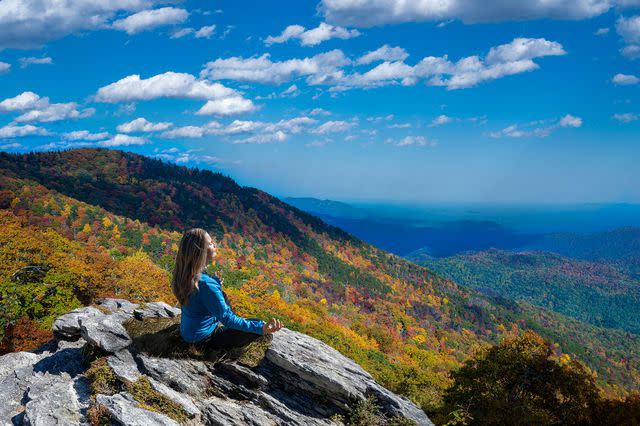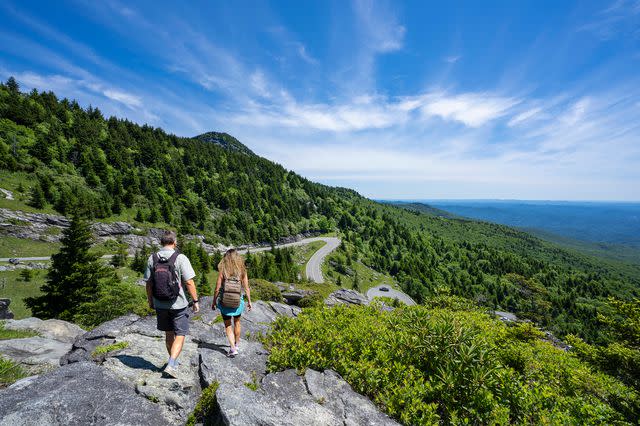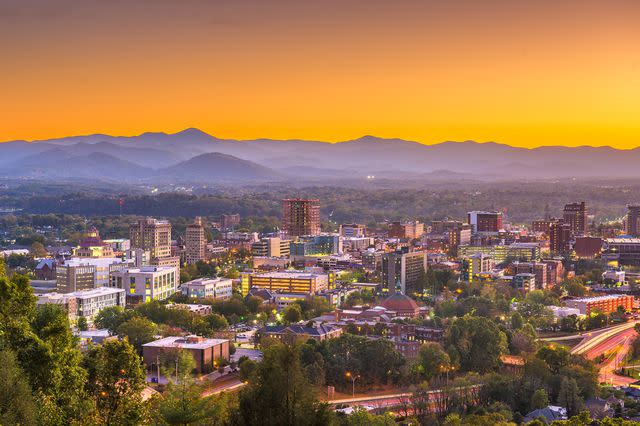This North Carolina City Is Called the 'Sedona of the South' — Here's Why
Energy vortexes and a focus on holistic well-being are just two of the characteristics shared by Asheville and Sedona.

Courtesy of Visit NC
Comparing two destinations, particularly ones more than 1,800 miles apart, can initially present an apples-to-oranges conundrum. On the surface, Asheville and Sedona are nothing alike. One is the largest city in the mountainous region of Western North Carolina; the other is a desert town in Arizona. Asheville’s natural palette includes varying shades of green and blue, while Sedona is known for its unmistakable red rock formations. Their similarities, however, are found on a deeper level — one that encompasses history, geography, wellness, and spirituality.

MargaretW/Getty Images
Ley Lines and Energy Vortexes
For many, the draw to Sedona revolves around its vortexes, an energy phenomenon also said to be present in Asheville. Miranda Peterson Harton, founder and owner of Asheville’s Namaste in Nature, describes vortexes in relation to ley lines, a concept originated by amateur archaeologist Alfred Watkins in the 1920s. While Watkins thought of ley lines as prehistoric walking paths or trade routes defined by invisible roads connecting various ancient structures and landmarks, the idea has had different interpretations over the years.
“I would think of ley lines as energy lines,” Harton tells Travel + Leisure. “Where the ley lines intersect is said to be like a vortex.” She says ley lines are “more felt than seen and measured,” and Asheville and Sedona — along with California’s Mount Shasta — are places where they converge. The idea of ley lines and energy vortexes is certainly a pseudoscience, but some believe these places are highly conducive to what Harton describes as “physical, mental, emotional, or energetic healing.”
Related: These Amazing Hiking Trails in Sedona Lead to Red-rock Arches and Hidden Energy Vortexes
Harton shares she’s not an expert in vortexes, per se, but has done extensive research on Asheville’s vortex. She has also felt it herself. “You can feel a shift in energy throughout the area in and around Asheville, but there are specific spots in the mountains where the [vortexes] seem to be more concentrated,” she says. To help others find — and reap the benefits of — these centers of energy, Harton and her team lead outdoor hiking, yoga, and meditation micro retreats in the area. On these two-hour excursions, they use practices like yoga, meditation, and mindfulness to “enhance” the participant’s experience with the vortex and Asheville’s natural resources in general.
Because whether or not you believe in ley lines and vortexes, there’s no arguing that being outside is good for physical and mental health. There are science-backed reasons people hike for hours on end, go desert bathing, and find solace while walking on the beach. Yes, you can soak up some vitamin D and reduce your cortisol levels virtually anywhere — including your own backyard — but Asheville and Sedona are similar in that they’re both incredibly rich in natural beauty. Asheville sits squarely in the Blue Ridge Mountains, and Sedona is surrounded by nearly two million acres of national forest land. This access to the great outdoors is, at least partially, the reason the two cities center themselves around their health and well-being offerings, attracting travelers from around the world.

MargaretW/Getty Images
The Beginning of Wellness Tourism
Tourism and the idea of holistic healing didn’t take off in Sedona until the mid- to late 20th century — spurred by the vortexes and New Age movement — but Asheville’s transformation into a wellness destination began much earlier.
Like many towns and cities, Asheville was heavily affected by railroad expansion in the 1880s. “Up to that point, since the earliest days of European settlement in the late 1700s, Asheville was hard to get to,” explains Kevan Frazier, an Asheville native, founder of Asheville by Foot Walking Tours, and executive director of Western Carolina University programs in Asheville. With more accessible travel, Asheville underwent a rapid transformation; its population grew 291 percent from 1880 to 1890.
At the same time, Asheville was becoming a popular destination for those seeking relief from various ailments, particularly pulmonary conditions. According to Frazier, there was a group of physicians, most notably Karl von Ruck and Samuel Westray Battle, who were instrumental in shaping Asheville’s new identity. “They had national reputations as physicians, and they were the ones who began to connect and work with some of the hotels and resorts to… bill Asheville as a great health resort, a place to come to whenever you [needed] fresh mountain air,” he says. That mountain air was especially appealing for those suffering from tuberculosis. “There were a number of sanatoriums, and they would have what were called breathing porches out front,” says Frazier. “The idea was that fresh air would be good… [and] it relieved a lot of their symptoms.”
To learn more about Asheville’s history as a wellness destination, Frazier recommends visiting the Asheville Museum of History, which opened this past fall.
Asheville’s relatively moderate climate — as well as its proximity to trees and natural hot springs — went on to fuel tourism for decades, initially drawing people out of cities like Charleston, New York, Philadelphia, and Boston. South Carolinians were hoping to escape the oppressive humidity, while those from the Northeast were in search of better air quality. One of those visitors was a man named George Vanderbilt. Vanderbilt brought his mother to Asheville to aid in her recovery from a chronic case of malaria. “While he was here, he was very much taken with the place and its natural beauty; he decided that he wanted to buy some land and build what was originally going to be a summer retreat,” says Frazier. That, of course, became the Biltmore Estate.

Sean Pavone/Getty Images
Today’s Asheville
Modern-day Asheville has certainly evolved from tuberculosis sanatoriums and breathing porches, but it hasn’t strayed from this health-focused through line. Yoga, massage therapy — in its many forms and practices — artificial salt caves, and meditation all play a role in Asheville’s wellness offerings. Frazier also says people are still drawn to the city for its “fresh outdoor spaces,” but there’s more of a focus on “outdoor tourism” — things like zip lining, hiking, water sports, and rock climbing. Coincidentally, several of those activities are also commonly practiced in Sedona.
Along with energy vortexes and health benefits, Asheville and Sedona share a history of the displacement of Native Americans. Long before the arrival of European settlers, the area we now know as Asheville was once inhabited by the Eastern Band of Cherokee Indians. To learn more about their heritage, visit the Museum of the Cherokee People in Cherokee, North Carolina, just over an hour’s drive from Asheville.
The Verde Valley, where you’ll find Sedona, was home to the Sinagua, Yavapai, Hopi, and Apache peoples. The Verde Valley Archaeology Center and Museum in Camp Verde, Arizona, is a great resource if you’d like to gain a more well-rounded understanding of American Indian history through archeology.
For more Travel & Leisure news, make sure to sign up for our newsletter!
Read the original article on Travel & Leisure.

